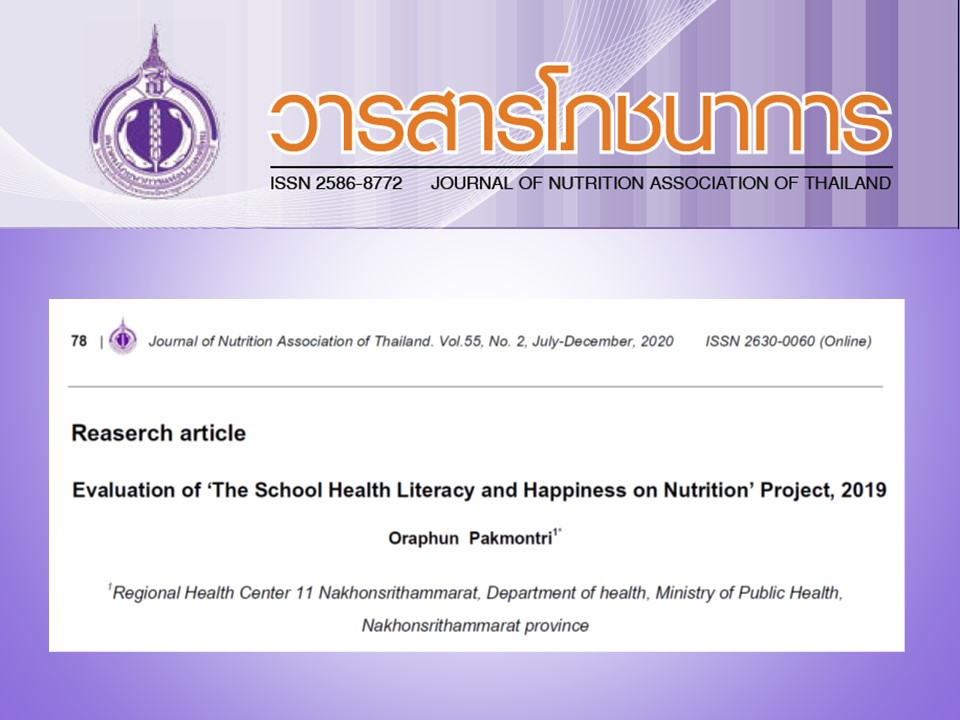Evaluation of ‘The School Health Literacy and Happiness on Nutrition’ Project, 2019
Keywords:
Health Literacy, Health Promotion School, CIPP modelAbstract
The school health literacy and happiness project builds on the health promoting school initiated by the Department of Health, aiming to strengthen health education and promotion in schools. Objective: This study evaluated the project performance on nutrition, clean and safe drinking water, and four learning behaviors. The CIPP Model (consisted of 4 components: context, inputs, process and products), was used as the framework to assess the project performance. Data were collected during January and February 2019, using a non-participatory observation and review of project’s documents. Eighteen schools from 7 provinces (Chumphon, Ranong, Pang-Nga, Phuket, Krabi, Surat Thani, and Nakhon Si Thammarat) of the 11th regional health promoting center were purposively selected. Main findings: Context: school principals, teachers, students, school committee, and community were well aware of and participated in building the new project components into the existing health promoting schools. The transition was smooth with strong support and participation of the community, and has a potential for scaling up. Inputs: all schools were aware of the policy and made efforts to move from health promoting schools to become health literacy schools. Some weaknesses included nutrition literacy, food hygiene and safe drinking water. Better performed schools can serve as a learning model. Process: Comparing schools having the same level of inputs and competency, different approaches were used and resulted in innovations. Experiences were shared at the School Health Literacy and Happiness Exhibits. ‘Best Practices’ were shared and recommended for adaptation to suit the differences in the contexts and environment of the schools. Products: all 18 schools were comparable in their outcomes. Aspects required improvement included: anthropometric assessment and coverage of height and weight measurements, high obesity rate (especially in the city area), canteen management to meet food sanitation standard, namely, health check-up of food providers, waste management, quality checking of drinking water, and lastly, classroom environment to promote learning behaviors. Recommendations: keys to successful health literacy include deep understanding, interactive communication, decision to change behaviors, and ability to transfer the acquired knowledge. One possibility is to integrate health literacy activities into the existing boy scout or girl guide programs, recognizing that support and facilitation be suitable to student’s age.
References
วชิระ เพ็งจันทร์,ชะนวนทอง ธนสุกาญจน์แนวคิด หลักการขององค์กรรอบรู้ด้านสุขภาพ 2561: 8: สำนักงานโครงการขับเคลื่อนกรมอนามัย 4.0; กรมอนามัย กระทรวงสาธารณสุข 2561.
ชะนวนทอง ธนสุกาญจน์,วิมล โรมา,มุกดา สำนวนกลาง, แนวคิด หลักการขององค์กรรอบรู้ด้านสุขภาพ. กรมอนามัย กระทรวงสาธารณสุข, 2561.
วันชัย เยี่ยงกุลเชาวน์, คู่มือการดำเนินงานโรงเรียนรอบรู้สุขภาพดี มีความสุข.ศูนย์อนามัยที่ 11 นครศรีธรรมราช, 2561.
เชาว์ อินใย การประเมินโครงการ, สำนักพิมพ์แห่งจุฬาลงการณ์มหาวิทยาลัย 2553: 126-127.
ไปรมา กลิ่นนิรัญ ผลของการเสริมสร้างพลังอำนาจต่อพฤติกรรมการดูแลตนเองของผู้ป่วยความดันโลหิตสูงของโรงพยาบาลท่าโรงช้าง อำเภอพุนพิน จังหวัดสุราษฎร์ธานี. วารสารพัฒนาสุขภาพชุมชน มหาวิทยาลัยขอนแก่น, 2558; 3(2):213-30.
ชลดา อานี กรัณฑรัตน์ บุญช่วยธนาสิทธิ์ ประเสริฐ์ศักดิ์ กายนาคา. ประสิทธิผลของโปรแกรมการสร้างเสริมความรอบรู้ทางสุขภาพโดยการจัดการเรียนรู้แบบใช้คำถามเพื่อสร้างเสริมพฤติกรรมการป้องกันการมีเพศสัมพันธ์ในนักเรียนระดับมัธยมศึกษาตอนต้น จังหวัดนนทบุรี. Kasetsart Educ Rev. 2560; 32(2):137-44.
สุธี สฤษฎิ์ศิริ ภาวะโภชนาการของนักเรียนในโรงเรียน เขตทวีวัฒนา กรุงเทพมหานคร. J Public Health. 2012; 42(1):78-89.

Downloads
Published
How to Cite
Issue
Section
License
Upon acceptance of an article, copyright is belonging to the Nutrition Association of Thailand.


